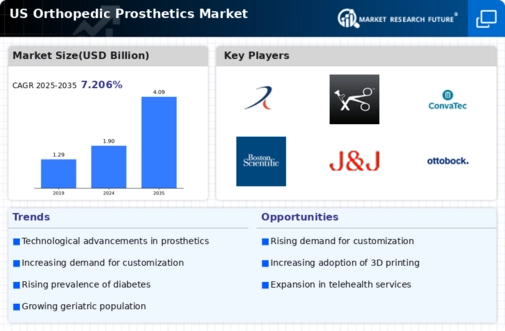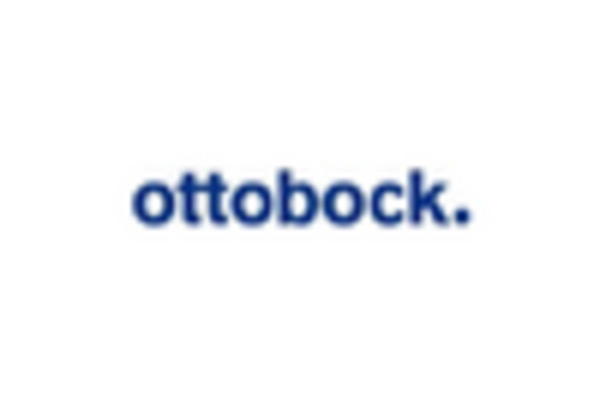Rising Incidence of Limb Loss
The orthopedic prosthetics market is experiencing growth due to the increasing incidence of limb loss in the US. Factors contributing to this trend include diabetes, vascular diseases, and traumatic injuries. According to the Amputee Coalition, approximately 2 million people in the US are living with limb loss, and this number is projected to double by 2050. This rising prevalence necessitates the demand for advanced prosthetic solutions, thereby driving the orthopedic prosthetics market. Furthermore, the aging population is more susceptible to conditions leading to limb loss, which further amplifies the need for effective prosthetic devices. As healthcare providers focus on improving patient outcomes, the orthopedic prosthetics market is likely to expand significantly in response to these demographic shifts.
Growing Awareness and Advocacy
Awareness and advocacy for limb loss and prosthetic solutions are crucial drivers of the orthopedic prosthetics market. Organizations such as the Amputee Coalition play a significant role in educating the public and healthcare professionals about the challenges faced by amputees. This increased awareness fosters a supportive environment for individuals seeking prosthetic solutions, encouraging them to pursue treatment options. Additionally, advocacy efforts lead to improved policies and funding for prosthetic research and development. As more individuals become informed about the benefits of modern prosthetics, the orthopedic prosthetics market is likely to see a surge in demand, as patients actively seek out advanced solutions to enhance their mobility and independence.
Increased Healthcare Expenditure
The orthopedic prosthetics market is positively influenced by the rising healthcare expenditure in the US. With healthcare spending projected to reach approximately $6 trillion by 2027, there is a growing investment in advanced medical technologies, including prosthetics. This increase in funding allows for better research and development, leading to innovative prosthetic solutions that improve patient quality of life. Moreover, as insurance coverage for prosthetic devices expands, more patients gain access to necessary treatments. This trend is likely to stimulate demand within the orthopedic prosthetics market, as healthcare providers strive to offer comprehensive care solutions that address the needs of individuals with limb loss.
Advancements in Materials and Manufacturing
Innovations in materials and manufacturing processes are pivotal drivers of the orthopedic prosthetics market. The introduction of lightweight, durable materials such as carbon fiber and advanced polymers enhances the functionality and comfort of prosthetic devices. Additionally, 3D printing technology is revolutionizing the production of custom prosthetics, allowing for tailored solutions that meet individual patient needs. This technology not only reduces production costs but also shortens lead times, making prosthetics more accessible. As a result, the orthopedic prosthetics market is poised for growth, with an increasing number of patients benefiting from personalized and high-quality prosthetic solutions. The integration of smart technologies, such as sensors and IoT, further enhances the capabilities of modern prosthetics, indicating a promising future for the industry.
Technological Integration in Rehabilitation
The integration of technology in rehabilitation processes is emerging as a key driver for the orthopedic prosthetics market. Innovative rehabilitation programs that incorporate virtual reality, robotics, and telehealth are enhancing recovery outcomes for amputees. These technologies facilitate personalized rehabilitation plans, allowing patients to engage in more effective therapy sessions. As healthcare providers increasingly adopt these advanced rehabilitation methods, the demand for compatible prosthetic devices rises. This trend suggests a symbiotic relationship between rehabilitation technologies and the orthopedic prosthetics market, where advancements in one area drive growth in the other. Consequently, the orthopedic prosthetics market is likely to benefit from the ongoing evolution of rehabilitation practices, leading to improved patient outcomes.

















Leave a Comment